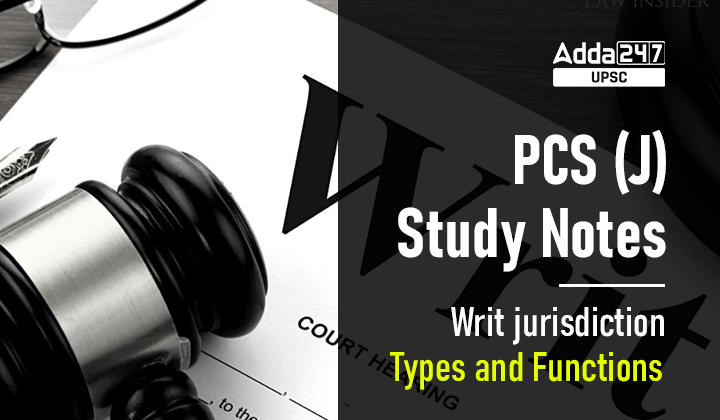Writ Jurisdiction
The exclusive authority to issue writs rests with the Supreme Court and the High Courts. The Supreme Court has this power under Article 32, whereas the high courts have it under Article 226. A person’s constitutional rights are protected by the Supreme Court, as outlined in Article III of the Constitution. The Supreme Court has the authority to make orders, guidelines, and writs in accordance with Article 32(2) of the Constitution. The protection of fundamental rights and “any other reason” are two examples listed in Article 226, which enable state high courts the authority to issue the writs.
Types of Writs
Five types of writs can be issues for the protection of Fundamental Rights:
- Habeas Corpus
Habeas Corpus literally means “to have the body of” in Latin. This writ is used to protect the right to personal liberty from arbitrary confinement. This writ may be issued by the Supreme Court or High Court against either private or government bodies.
- Mandamus
Its literal meaning is “We command,” and it’s employed when a public servant has either stopped doing his job or flat-out refused to do it. A mandamus cannot be served on a private citizen or a company with no public duties. A mandamus cannot be served on a private citizen or a company with no public duties.
- Prohibition
Prohibition means “to forbid” in its etymological root. A Prohibition writ is issued by a superior court to a subordinate court when the inferior court appears to be trying to exercise jurisdiction over an issue outside of its purview.
- Quo warranto
The writ issues an order to the subordinate authority to show by what authority they are exercising their power. Medieval Latin used the phrase “under what warrant” (quo warranto) to describe this situation. Nobody working in the private sector can apply for the writ.
- Certiorari
When the Supreme Court issues a writ of certiorari, lower courts and quasi-courts are directed to transfer the relevant case files so that the Supreme Court can review them and decide whether or not the lower courts acted within their authority or whether or not they violated the principles of natural justice. A temporary injunction in the form of a writ of certiorari.
Functions
- The writ of Habeas Corpus is issued when someone has been unlawfully detained by the police.
- The Supreme Court could issue a Quo Warranto against an unconstitutional government or public official to prevent them from assuming their position in government without the necessary qualifications.
- The government or its officials are the primary targets of a writ of Prohibition, even though they do not have the authority or jurisdiction to rule on the matter at hand.
- When the statutory authorities charged with carrying out an obligation fail to do so, the writ of mandamus may be issued.
- The statutory authorities with judicial or quasi judicial functions are the usual targets of a writ of Certiorari.
रिट क्षेत्राधिकार
रिट जारी करने का विशेष अधिकार सर्वोच्च न्यायालय और उच्च न्यायालयों के पास है। सर्वोच्च न्यायालय के पास यह शक्ति अनुच्छेद 32 के तहत है, जबकि उच्च न्यायालयों के पास अनुच्छेद 226 के तहत है। एक व्यक्ति के संवैधानिक अधिकार सर्वोच्च न्यायालय द्वारा संरक्षित हैं, जैसा कि संविधान के अनुच्छेद III में उल्लिखित है। सुप्रीम कोर्ट को संविधान के अनुच्छेद 32(2) के अनुसार आदेश, दिशा-निर्देश और रिट बनाने का अधिकार है। मौलिक अधिकारों की सुरक्षा और “कोई अन्य कारण” अनुच्छेद 226 में सूचीबद्ध दो उदाहरण हैं, जो राज्य के उच्च न्यायालयों को रिट जारी करने का अधिकार देते हैं।
रिट के प्रकार
मौलिक अधिकारों के संरक्षण के लिए पांच प्रकार के रिट मुद्दे हो सकते हैं:
- बंदी प्रत्यक्षीकरण
बंदी प्रत्यक्षीकरण का लैटिन में शाब्दिक अर्थ है “शरीर का होना”। इस रिट का उपयोग व्यक्तिगत स्वतंत्रता के अधिकार को मनमानी कारावास से बचाने के लिए किया जाता है। यह रिट सर्वोच्च न्यायालय या उच्च न्यायालय द्वारा निजी या सरकारी निकायों के खिलाफ जारी की जा सकती है।
- मंडामुस
इसका शाब्दिक अर्थ है “हम आज्ञा देते हैं,” और यह तब नियोजित होता है जब किसी लोक सेवक ने या तो अपना काम करना बंद कर दिया हो या फ्लैट-आउट करने से इनकार कर दिया हो। एक निजी नागरिक या बिना सार्वजनिक कर्तव्यों वाली कंपनी पर एक परमादेश नहीं परोसा जा सकता है। एक निजी नागरिक या बिना सार्वजनिक कर्तव्यों वाली कंपनी पर एक परमादेश नहीं परोसा जा सकता है।
- निषेध
निषेध का अर्थ है “निषिद्ध करना” इसकी व्युत्पत्ति संबंधी जड़ में। एक उच्च न्यायालय द्वारा एक अधीनस्थ न्यायालय को निषेध रिट जारी की जाती है जब निम्न न्यायालय अपने अधिकार क्षेत्र से बाहर किसी मुद्दे पर अधिकार क्षेत्र का प्रयोग करने का प्रयास कर रहा हो।
- क्यू वारंटो
रिट अधीनस्थ प्राधिकारी को यह दिखाने के लिए एक आदेश जारी करती है कि वे किस अधिकार से अपनी शक्ति का प्रयोग कर रहे हैं। मध्यकालीन लैटिन ने इस स्थिति का वर्णन करने के लिए “किस वारंट के तहत” (क्वो वारंटो) वाक्यांश का इस्तेमाल किया। निजी क्षेत्र में काम करने वाला कोई भी व्यक्ति रिट के लिए आवेदन नहीं कर सकता है।
- प्रमाणिक
जब सर्वोच्च न्यायालय प्रमाणिकता की रिट जारी करता है, तो निचली अदालतों और अर्ध-न्यायालयों को संबंधित मामले की फाइलों को स्थानांतरित करने का निर्देश दिया जाता है ताकि सुप्रीम कोर्ट उनकी समीक्षा कर सके और तय कर सके कि निचली अदालतों ने अपने अधिकार के भीतर काम किया या नहीं या उन्होंने उल्लंघन किया है या नहीं। प्राकृतिक न्याय के सिद्धांत। सर्टिफिकेट के रिट के रूप में एक अस्थायी निषेधाज्ञा।
रिट के कार्य
- बंदी प्रत्यक्षीकरण की रिट तब जारी की जाती है जब किसी को पुलिस द्वारा गैरकानूनी रूप से हिरासत में लिया गया हो।
- सुप्रीम कोर्ट एक असंवैधानिक सरकार या सार्वजनिक अधिकारी के खिलाफ आवश्यक योग्यता के बिना सरकार में अपना पद संभालने से रोकने के लिए एक क्यू वारंट जारी कर सकता है।
- सरकार या उसके अधिकारी निषेध के एक रिट के प्राथमिक लक्ष्य हैं, भले ही उनके पास इस मामले पर शासन करने का अधिकार या अधिकार क्षेत्र नहीं है।
- जब एक दायित्व को पूरा करने के आरोप में वैधानिक प्राधिकरण ऐसा करने में विफल हो जाते हैं, तो परमादेश की रिट जारी की जा सकती है।
- न्यायिक या अर्ध-न्यायिक कार्यों वाले वैधानिक प्राधिकरण प्रमाणिक के एक रिट के सामान्य लक्ष्य हैं।



 TSPSC Group 1 Question Paper 2024, Downl...
TSPSC Group 1 Question Paper 2024, Downl...
 TSPSC Group 1 Answer key 2024 Out, Downl...
TSPSC Group 1 Answer key 2024 Out, Downl...
 UPSC Prelims 2024 Question Paper, Downlo...
UPSC Prelims 2024 Question Paper, Downlo...





